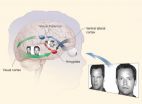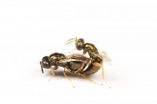(Press-News.org) High school students whose friends' average grade point average (GPA) is greater than their own have a tendency to increase their own GPA over the course of a year, according to research published February 13 in the open access journal PLOS ONE by Hiroki Sayama from Binghamton University and his collaborators from Maine-Endwell High School in Endwell, New York, including four high school student researchers.
Previous studies have shown that a student's social network can influence obesity, emotional state and other cognitive traits and behavior. However, this is the first to examine how peer groups can influence academic progress over time. To assess this effect, the researchers first asked eleventh grade students to categorize their peers as best friends, friends, acquaintances, strangers or relatives. The researchers then mapped how students performed in school relative to their peer group, and correlated their social network with the change of their academic performance over time.
They found that students' whose friends were performing better academically were more likely to improve their own scores over time. The opposite effect was also seen: When their friends' GPA were lower, a given student's GPA was more likely to decrease as well.
The authors also found that the strongest link between a student's GPA change and that of their peers was likely to be with those they had ranked as friends, rather than best friends or acquaintances. They state, "While most educators already know the importance of social environment for a student's academic success, our study presents the first quantitative supporting evidence for such empirical knowledge."
###
Citation: Blansky D, Kavanaugh C, Boothroyd C, Benson B, Gallagher J, et al. (2013) Spread of Academic Success in a High School Social Network. PLoS ONE 8(2): e55944. doi:10.1371/journal.pone.0055944
Financial Disclosure: This material is based upon work supported by the US National Science Foundation under Grant No. 1027752. The funders had no role in study design, data collection and analysis, decision to publish, or preparation of the manuscript.
Competing Interest Statement: The authors have declared that no competing interests exist.
PLEASE LINK TO THE SCIENTIFIC ARTICLE IN ONLINE VERSIONS OF YOUR REPORT (URL goes live after the embargo ends): http://dx.plos.org/10.1371/journal.pone.0055944
GPA may be contagious in high-school social networks
Academic success in high school correlates with students’ friendship networks
2013-02-14
ELSE PRESS RELEASES FROM THIS DATE:
Long, low intensity exercise may have more health benefits relative to short, intense workouts
2013-02-14
Standing and walking for longer stretches improves insulin sensitivity and blood lipid levels more than an hour of intense exercise each day does, but only if the calories spent in both forms of exercise are similar. The findings are published February 13 in the open access journal PLOS ONE by Hans Savelberg and colleagues from Maastricht University, Netherlands.
The researchers recruited eighteen normal-weight 19 to 24-year-old participants for their study and asked them to follow three regimes. In the first, participants were instructed to sit for 14 hours each day ...
New owl species discovered in Indonesia is unique to one island
2013-02-14
A new owl is the first endemic bird species discovered on the island of Lombok, Indonesia, according to research published February 13 in the open access journal PLOS ONE by an international team headed by George Sangster of the Swedish Museum of Natural History and colleagues from other institutions.
The new species has long been confused with a more widespread Indonesian owl species because of its similar plumage. However, in September 2003, two members of the team independently discovered that the vocalizations of the owls on Lombok were unique and different from ...
The party in your brain
2013-02-14
A team of political scientists and neuroscientists has shown that liberals and conservatives use different parts of the brain when they make risky decisions, and these regions can be used to predict which political party a person prefers. The new study suggests that while genetics or parental influence may play a significant role, being a Republican or Democrat changes how the brain functions.
Dr. Darren Schreiber, a researcher in neuropolitics at the University of Exeter, has been working in collaboration with colleagues at the University of California, San Diego on ...
Threat bias interacts with combat, gene to boost PTSD risk
2013-02-14
Soldiers preoccupied with threat at the time of enlistment or with avoiding it just before deployment were more likely to develop post-traumatic stress disorder (PTSD), in a study of Israeli infantrymen. Such pre-deployment threat vigilance and avoidance, interacting with combat experience and an emotion-related gene, accounted for more than a third of PTSD symptoms that emerged later, say National Institutes of Health scientists, who conducted the study in collaboration with American and Israeli colleagues.
"Since biased attention predicted future risk for PTSD, computerized ...
CU-Boulder amphibian study shows how biodiversity can protect against disease
2013-02-14
The richer the assortment of amphibian species living in a pond, the more protection that community of frogs, toads and salamanders has against a parasitic infection that can cause severe deformities, including the growth of extra legs, according to a new study by the University of Colorado Boulder.
The findings, published Feb. 14 in the journal Nature, support the idea that greater biodiversity in larger-scale ecosystems, such as forests or grasslands, may also provide greater protection against diseases, including those that attack humans. For example, a larger number ...
Sustainable new catalysts fueled by a single proton
2013-02-14
CHESTNUT HILL, MA (Feb. 14, 2013) – Chemists at Boston College have designed a new class of catalysts triggered by the charge of a single proton, the team reports in the most recent edition of the journal Nature. The simple organic molecules offer a sustainable and highly efficient platform for chemical reactions that produce sets of molecules crucial to advances in medicine and the life sciences.
Unearthing a reliable, truly general, efficient synthesis of single mirror-image isomers has proven elusive. Previous methods suffer from a combination of extreme temperatures, ...
'Significant' proportion of HIV positive patients may not be telling NHS staff about their infection
2013-02-14
A significant proportion of HIV positive patients may not be disclosing their infection to NHS staff, when turning up for treatment at sexual health clinics, suggests preliminary research published online in the journal Sexually Transmitted Infections.
If the findings reflect a national trend, this could have implications for the true prevalence of undiagnosed HIV infection in the population, which is based on the numbers of "undiagnosed" patients at sexual health clinics, say the authors.
Currently, it is estimated that around one in four people in the UK who is HIV ...
California's Tobacco Control Program generates huge health care savings, UCSF study shows
2013-02-14
Over a span of nearly 20 years, California's tobacco control program cost $2.4 billion and reduced health care costs by $134 billion, according to a new study by UC San Francisco.
Additionally, the study -- covering the beginning of the program in 1989 to 2008 -- found that the state program helped lead to some 6.8 billion fewer packs of cigarettes being sold that would have been worth $28.5 billion in sales to cigarette companies.
The study was designed to calculate the fiscal impact of California's large public health program on smoking prevalence and cigarette consumption. ...
Cracking the semantic code
2013-02-14
We make choices about pretty much everything, all the time – "Should I go for a walk or grab a coffee?"; "Shall I look at who just came in or continue to watch TV?" – and to do so we need something common as a basis to make the choice.
Dr John Fennell and Dr Roland Baddeley of Bristol's School of Experimental Psychology followed a hunch that the common quantity, often referred to simply as reward, was a representation of what could be gained, together with how risky and uncertain it is. They proposed that these dimensions would be a unique feature of all objects and ...
Finding 'Mr. Right,' how insects sniff out the perfect mate
2013-02-14
TEMPE, Ariz. – You may want to ramp up your romance this year by sharing a candlelight dinner, a walk on the beach, or even the scent of a perfume, but will that help you find your perfect mate? For one wasp species, it only takes a whiff of his special love potion to know whether he's "Mr. Right."
Unlike humans, most insects rely on their sense of smell when looking for a mate. Scientists have found that sex pheromones play an important role in finding a suitable partner of the same species; yet, little is known about the evolution and genetic basis of these alluring ...
LAST 30 PRESS RELEASES:
Anthropologist documents how women and shepherds historically reduced wildfire risk in Central Italy
Living at higher altitudes in India linked to increased risk of childhood stunting
Scientists discover a new signaling pathway and design a novel drug for liver fibrosis
High-precision blood glucose level prediction achieved by few-molecule reservoir computing
The importance of communicating to the public during a pandemic, and the personal risk it can lead to
Improving health communication to save lives during epidemics
Antimicrobial-resistant hospital infections remain at least 12% above pre-pandemic levels, major US study finds
German study finds antibiotic use in patients hospitalised with COVID-19 appears to have no beneficial effect on clinical outcomes
Targeting specific protein regions offers a new treatment approach in medulloblastoma
$2.7 million grant to explore hypoxia’s impact on blood stem cells
Cardiovascular societies propel plans forward for a new American Board of Cardiovascular Medicine
Hebrew SeniorLife selected for nationwide collaborative to accelerate system-wide spread of age-friendly care for older adults
New tool helps identify babies at high-risk for RSV
Reno/Sparks selected to be part of Urban Heat Mapping Campaign
Advance in the treatment of acute heart failure identified
AGS honors Dr. Rainier P. Soriano with Dennis W. Jahnigen Memorial Award at #AGS24 for proven excellence in geriatrics education
New offshore wind turbines can take away energy from existing ones
Unprecedented research probes the relationship between sleep and memory in napping babies and young children
Job losses help explain increase in drug deaths among Black Americans
Nationwide, 32 local schools win NFL PLAY 60 grants for physical activity
Exposure to noise – even while in the egg – impairs bird development and fitness
Vitamin D availability enhances antitumor microbes in mice
Conservation actions have improved the state of biodiversity worldwide
Corporate emission targets are incompatible with global climate goals
Vitamin D alters mouse gut bacteria to give better cancer immunity
Escape the vapes: scientists call for global shift to curb consumer use of disposable technologies
First-of-its-kind study definitively shows that conservation actions are effective at halting and reversing biodiversity loss
A shortcut for drug discovery
Food in sight? The liver is ready!
Climate change could become the main driver of biodiversity decline by mid-century
[Press-News.org] GPA may be contagious in high-school social networksAcademic success in high school correlates with students’ friendship networks


